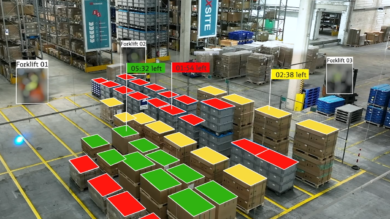The air freight industry has been facing unprecedented times since the global outbreak of the COVID-19 pandemic in early 2020. Airlines vastly canceled their passenger flights and grounded large parts of their fleets. Before the pandemic, air cargo was transported to roughly 60 % in the belly holds of passenger aircrafts and 40 % with freighter aircrafts. This capacity share of belly and freighters shifted to about 10:90 in Q2/2020. The trend has recovered to some extent but is not expected to fully reverse in the following years. While capacities have remained scarce, air cargo demand has seen a strong rebound since mid of 2020. As a result of the gap between capacity and demand, air freight rates have surged and imposed significant challenges to the air freight industry and global supply chains at large.
Ongoing disruptions in ocean freight with capacity and container shortages, port congestions, and recent closures of major seaports in China have led to a further strong push for air freight as well as an upturn in the global economy in general. Market dynamics have accelerated, but at the same time, continuously comes along with a high level of volatility in the air freight marketplace.
AI in air freight and why it is needed
The described business conditions result in significant uncertainties regarding mid-term capacity planning and the overall procurement strategy of air freight forwarders. Having agile and lean processes and tools to properly evaluate and balance potential business opportunities and associated risks becomes a decisive factor. Data-driven decisions are crucial to mitigate capacity and network planning risks and make better overall predictions on future developments in the logistics market.
Data to drive decisions
There are many ways in which data, in a broader sense, can be used to drive business decisions. The fundamental is monitoring the business environment and storing this information for future use. Also, part of a data-driven approach measures the effect of decisions for future conclusions. Depending on the data available, a decision support software tool can support humans in the decision-making process or even make or suggest decisions itself. Decision support software often applies machine learning (prediction) and or operations research (optimization) methods.
AI for air freight at DB Schenker
DB Schenker, for example, recently launched a new air freight forecasting tool for tradelane-specific charter rates and risk assessment based on AI.
“We live in volatile times, and a lot of unpredictable things happen. We at DB Schenker have committed ourselves to drive that actively to take our customers further despite any challenges and changes within the market. Our long-term know-how and expertise together with our new AI tool is a powerful combination to enable this.”
The tool is a hybrid solution between simulation and prediction. It allows for user-adapted simulations but is backed with a prediction logic estimated on historical data. A capacity and volume outlook serves as input for the prediction. The user can decide which outlook to choose, i.e., a third-party expert market forecast, a manual adaption, a simple heuristic, or a time series forecast internally developed.

Based on these decisions, the tool then calculates a prediction of the charter rates as output. For that prediction, the tool uses a model DB Schenker internally developed. Comparing the forecasted regular rates with the expected charter and longer-term procured air freight rates allow the company to conclude strategic procurement decisions in air freight, namely:
- Will regular rates remain more expensive than chartering aircrafts?
- When is this tipping point expected, relatively soon or at the end of the planning time frame?
- It also allows you to get a feeling of the sensitivity of the assumptions on the rate forecast. For example, how much does the capacity have to recover for a tipping point to be expected?
AI for air freight – Outlook
This tool is one of many examples of how decision-making processes can be shifted from implicit intuitive expert experience to explainable decisions backed up with tangible scenarios based on data. That does not necessarily imply that technology replaces human decisions; in the first place, it supports humans to make better decisions with more precise background information. In doing so, such data-driven decision support contributes to developing tailored, competitive capacity solutions for the transport needs of logistics service providers and their customers.
Published: October 2021










